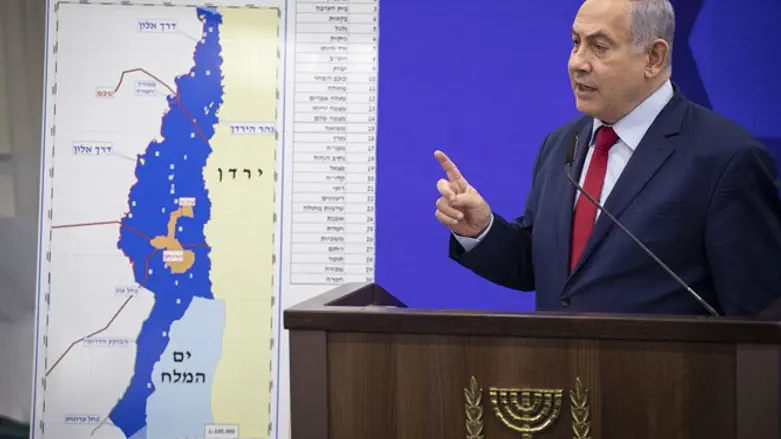
Prime Minister Binyamin Netanyahu is considering major alterations to his soon-to-be released sovereignty plan, according to a report Wednesday by Israel Hayom.
According to multiple officials cited by the report, Netanyahu is considering breaking up the plan to apply Israeli sovereignty over roughly 30% of Judea and Samaria into two separate stages.
Under the original plan, Israel was to have applied its sovereignty to most of the Jordan Valley and all Israeli towns in Judea and Samaria, and the Dead Sea coast after July 1st.
That plan drew fierce criticism from the European Union, Jordan, and even parts of the Israeli Right, who claimed the plan would leave a number of Israeli towns in Judea and Samaria isolated, and could lay the groundwork for a back door to Palestinian statehood.
In addition, the US has indicated that for the plan to receive American recognition, it must be endorsed by Netanyahu’s coalition partner, the Blue and White party.
The relationship between the sovereignty plan and the Trump administration’s Middle East peace plan, which links American recognition of Israeli sovereignty in parts of Judea and Samaria to Israel’s willingness to commit to final status talks with the Palestinian Authority, remains unclear, and has become an additional challenge to Netanyahu’s goal of bringing the sovereignty plan to a vote in the Knesset next month.
To alleviate these difficulties, multiple officials informed Israel Hayom, Netanyahu is mulling breaking up the sovereignty plan into two stages.
Under the new proposal now being weighed, Israel would apply sovereignty to 10% of Judea and Samaria, covering Israeli towns outside of the major settlement blocs and far from the pre-1967 border.
That would leave the Jordan Valley, the larger settlement blocs, and roughly two-thirds of the territory Israel seeks to apply sovereignty to outside of the first step.
It is hoped that doing so will reduce tensions with Jordan, and signal to the European Union that Israel is taking international criticism of its plan seriously.
After the first step, Israel would then issue a call to the Palestinian Authority to immediately resume final status negotiations.
Israel would then give the PA several months to return to the negotiating table.
If, as is widely believed, the PA refuses to return to negotiations, Israel will then apply sovereignty to the remaining 20% of Judea and Samaria allocated to it in the sovereignty plan, including the Jordan Valley and major settlement blocs.
This approach, the Prime Minister hopes, will also win American backing for the plan by tying the application of sovereignty to an attempt to restart negotiations with the PA – while still avoiding explicitly endorsing Palestinian statehood in conjunction with the sovereignty plan.
Wednesday’s report said Netanyahu is also considering this two-step approach as a way to avoid clashing with the Trump administration or the Israeli Right over the boundaries of the sovereignty plan.
An initial map drawn up by Israel drew criticism from some settlement leaders, leading the prime minister to have a second map drawn, one more likely to win backing from the Israeli Right.
The joint Israeli-American team working to coordinate the details of the sovereignty plan have not been able to reach an agreement yet on the map.
The White House responded to the report, saying: “There still are no sovereignty maps. The mapping team is continuing its work, and the mapping process has yet to be completed.”
